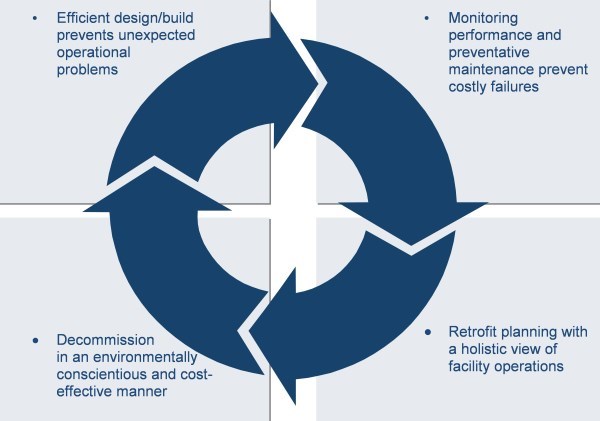
by Pramod Dibble, Frost & Sullivan Energy & Environment Research Analyst — The convergence of information technology (IT) and facilities management (FM) is an inevitable trend. The goal for facilities managers has always been to make buildings more energy-efficient, more productive and more comfortable for tenants and operators. Smart buildings solve all of these problems and at a lower total cost of ownership than conventional systems. One tool in the smart buildings repertoire is building information modeling.
Building information modeling (BIM) digitally manifests a structure to create a model that can be used to monitor and share information across the entire building life cycle. The advantages of this approach include dramatically increased efficiency of information-sharing between the multiplicity of parties and contractors that collaborate to build facilities. This collaborative approach reduces redundancies and miscommunications, thereby lowering upfront construction as well as ongoing maintenance and energy costs. Through the use of BIM, all planned systems can be integrated, visualized and optimized before construction begins. This holistic view provides a vehicle for design innovation, quality of construction and accuracy in cost to build, and operate estimates.
The highly fragmented nature of the construction industry has created a need for a centralized platform for information-sharing and control. With the increasing complexity of facilities, particularly in high-tech, luxury, or specialized facilities, the sheer volume of disciplines required to design and build a quality facility is large and growing. BIM provides one forum for collaboration, rather than the traditional spider web of individual firms all communicating independently. Additionally, given the traditional approach of individual contractors each using their own data and modeling tools, incompatibilities are bound to arise, causing significant losses to the industry and, subsequently, to client value. The dynamic nature of BIM incorporates changes and modifications made over the years, ensuring that it never becomes obsolete or less useful due to outdated records.
With the added pressure on building owners and operators to reduce energy usage and environmental impact, BIM allows for simulated testing and analysis of building systems before construction to ensure that adequate measures have been taken to guarantee expected performance and to change underperforming systems before they are installed.
BIM is useful even in existing facilities that were not built using an integrated, three-dimensional, digital model. Through the use of original and retrofit design plans, and in some cases laser scanning, a BIM model can be generated from an existing facility. This system can then be used to monitor and benchmark systems and suggest retrofit opportunities for operational efficiency and cost-savings. All of the ongoing advantages of a BIM platform will then be available to building owners and managers, and, while the system will be useful and cost-effective at all but the final stages of the building’s life cycle, its benefits increase the earlier it is implemented. The ability to trace contracts and performance over the lengthy period of facility usefulness is invaluable. It becomes much easier to review contracts and ensure fulfillment using an integrated model.
BIM is typically used in conjunction with cloud architecture. This approach allows contractor participants to access and review building information remotely, further increasing the collaborative potential and efficiency gains.
While the value proposition during the initial phases of design and construction is significant and can be measured directly in return on investment, other advantages of this approach exist as well and can have even more impact on the facility’s overall usefulness. More intelligent facility designs can improve occupant comfort and safety for office or residential facilities. Security concerns and evacuation planning can be built in an intuitive and efficient manner to promote the health and well-being of the occupants. Radio frequency identification interrogators and intelligent checkpoint planning can negate security weak points on a facility-wide level with the lowest negative impact on tenant comfort and ease of access. In the case of manufacturing plants, improved efficiency can be gained by modeling and controlling the manufacturing process and designing the most efficient assembly line possible. Product modeling can be accomplished, and off-site processes can be analyzed and tested digitally before implementation, with huge potential savings. In critical and complex environments, such as telecommunications and nuclear power plants, inefficient designs have a compound effect on cost to build, and coming in on budget necessitates the use of a master monitoring and testing system.
BIM is most effectively used in conjunction with smart buildings, which involve the dynamic integration of building and information systems. These buildings automatically detect and respond to changes in environment by using wireless sensors embedded in their exterior and interior surfaces. Sensors can detect and respond to daylight levels, outside temperatures, systems performance and possible deterioration, and automatically correct window tinting, blind positioning, and HVAC settings as well as alert facilities personnel to any anomalies. These systems are capable of anticipating conditions to respond in a timely fashion. By synchronizing integrated intelligent building systems with BIM, the most complete picture of a building’s status is possible and accessible in real time.
The integration of IT infrastructure and building systems is the next logical step for building owners and operators. The majority of costs associated with building management and maintenance is not in the design build stage but rather the ongoing costs of maintenance and energy use. Using advanced building techniques such as BIM and smart building integration can deliver huge cost-savings throughout the course of the building’s life cycle, as well as making it a more pleasant, desirable place to live or work. Building planning and construction is such a complex, multi-disciplinary industry that the opportunity lost by a lack of integrated information and collaborative communication between contractors and owners/operators is in the billions of dollars every year. Three-dimensional, digital modeling stored in the cloud solves all of these problems, and we expect to see dramatically increased utilization in the near future.
Sources:
http://www.wbdg.org/design/dd_infotecheng.php
http://www.aia.org/aiaucmp/groups/aia/documents/pdf/aiab080149.pdf
http://www1.eere.energy.gov/buildings/residential/index.html
http://www.ibm.com/smarterplanet/global/files/building_information_modelling_ibm_pov.pdf